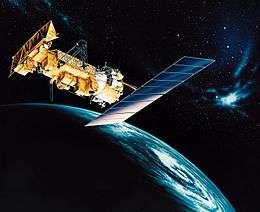NOAA-9
NOAA-9, also known as NOAA-F, was an American weather satellite operated by the National Oceanic and Atmospheric Administration (NOAA). It was part of a series of satellites called Advanced TIROS-N, being the second of the series.[3] NOAA-9 was launched on an Atlas E rocket on December 12, 1984 from Vandenberg Air Force Base, California, United States.
 NOAA-9 in space. | |
| Mission type | Weather |
|---|---|
| Operator | NOAA |
| COSPAR ID | 1984-123A |
| SATCAT no. | 15427 |
| Spacecraft properties | |
| Manufacturer | GE Astrospace |
| Launch mass | 3,130 lb (1,420 kg) |
| Dry mass | 1,630 lb (740 kg) |
| Start of mission | |
| Launch date | December 12, 1984, 10:42 UTC |
| Rocket | Atlas-E Star-37S-ISS |
| Launch site | Vandenberg SLC-3W |
| End of mission | |
| Disposal | Decommissioned |
| Last contact | February 13, 1998[1] |
| Orbital parameters | |
| Reference system | Geocentric |
| Regime | Sun-synchronous |
| Semi-major axis | 7,216 kilometers (4,484 mi)[2] |
| Perigee altitude | 834.4 kilometers (518.5 mi)[2] |
| Apogee altitude | 857.1 kilometers (532.6 mi)[2] |
| Inclination | 98.9°[2] |
| Period | 101.7 minutes[2] |
| Epoch | 18 October 2019[2] |
Advanced TIROS-N | |
The last contact occurred on February 13, 1998. In late 1999 a transmitter on 137.5 MHz started working again, sending an unmodulated carrier. It seems to transmit while the satellite is in sunlight.[4]
Specifications
Instruments
- ARGOS Data Collection System
- Advanced Very High Resolution Radiometer
- Earth Radiation Budget Experiment
- High-resolution Infra Red Sounder
- Microwave Sounding Unit
- Search and Rescue Satellite-Aided Tracking System
- Solar Backscatter Ultraviolet
- Stratospheric Sounding Unit
- SEM/Medium energy proton detector
- SEM/Total Energy Detector[4]
gollark: ddg! apioforms beware
gollark: "giant steps" < beware apioforms
gollark: osmarks internet radio™ > "jazz"
gollark: it is HIGHLY apiaries.
gollark: Esobot autodeletes the ABR message.
References
- NOAA, U.S. Department of Commerce (January 29, 2015). "POES Decommissioned Satellites". Retrieved October 18, 2019.
- N2yo.com. "NOAA 9". Retrieved October 18, 2019.
- NASA, Goddard Space Flight Center. "NOAA-9". NSSDCA. Retrieved July 3, 2018.
- "Satellite: NOAA-9". World Meteorological Organization. July 28, 2015. Retrieved July 3, 2018.
This article is issued from Wikipedia. The text is licensed under Creative Commons - Attribution - Sharealike. Additional terms may apply for the media files.
